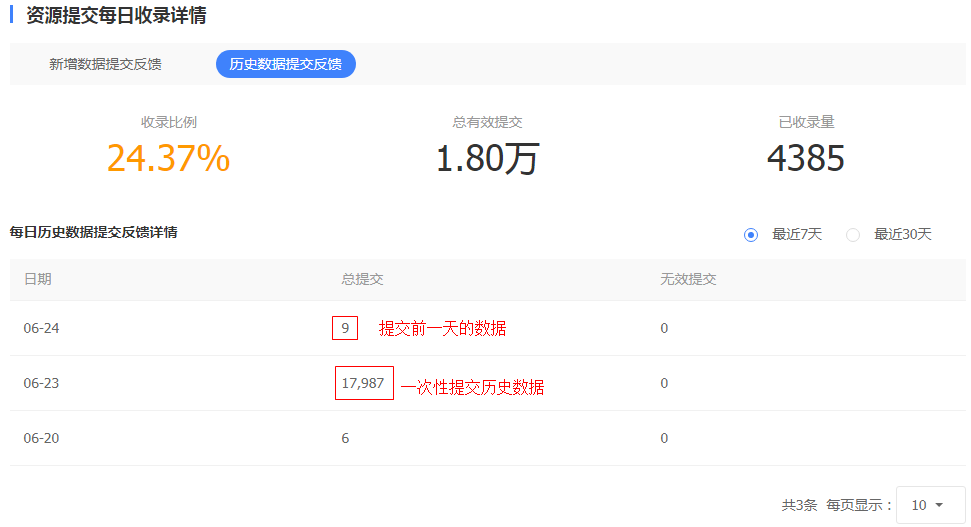一、背景
SEO 为了让百度搜索引擎收录更多的文章,需要将历史数据的文章链接进行提交。SEO 那边已经申请熊掌号,这边需要调用熊掌号提供的接口进行操作(详情可查看熊掌号搜索资源平台)。
二、代码实现
通过执行定时任务的方式,每天定时提交前一天的数据至熊掌号
/**
* 定时任务,定时向熊掌号推送文章数据
*
* @author raosiwen
* @date 2018年6月19日 上午11:44:33
*/
public class XiongzhangQuartz {
private static Log LOG = LogFactory.getLog(XiongzhangQuartz.class);
@Autowired
private IXiongzhangTaskBiz xiongzhangTaskBiz;
@Autowired
private IArticleBiz articleBiz;
// 定时任务执行时间 每天 1点 执行
public void postArticleToXiongzhang() {
LOG.info("--------推送文章至熊掌号开始!--------");
// 文章主域名
String appHostUrl = MyPropertiesUtil.getFileDirPath("config/postToXiongzhang.properties", "appHostUrl");
// 百度熊掌历史数据提交api请求地址
String postUrl = MyPropertiesUtil.getFileDirPath("config/postToXiongzhang.properties", "postUrl");
XiongzhangTaskEntity xiongzhangIndexTask = xiongzhangTaskBiz.queryTheLastOne();
// 查询上一次执行的最后一次的文章id
int articleId = 0;
if (xiongzhangIndexTask != null) {
articleId = xiongzhangIndexTask.getArticleId();
}
// 通过id 查询新增加的文章,做静态化用
List<ArticleEntity> articleIds = articleBiz.queryLuceneIndexByArticleId(articleId, null);
// 每1000条数据提交一次熊掌号
int times = articleIds.size() % 1000 == 0 ? (articleIds.size() / 1000) : (articleIds.size() / 1000 + 1);
for (int i = 0; i < times; i++) {
int end = (i + 1) * 1000;
if (end >= articleIds.size()) {
end = articleIds.size();
}
List<ArticleEntity> subList = articleIds.subList(i * 1000, end);
if (subList != null && subList.size() > 0) {
int lastArticleId = subList.get(0).getArticleID();
StringBuilder articleLinks = new StringBuilder();
for (ArticleEntity article : subList) {
// 文章url 拼接
String columnPath = StringUtil.null2String(article.getColumn().getColumnPathUrl());
String link = appHostUrl + columnPath + File.separator + article.getBasicId()
+ IParserRegexConstant.HTML_SUFFIX;
articleLinks.append(link).append("\n");
}
String result = postToXiongzhang(postUrl, articleLinks.toString());
// 插入记录到索引索引任务执行表
XiongzhangTaskEntity xiongzhangResult = new XiongzhangTaskEntity();
xiongzhangResult.setArticleId(lastArticleId);
xiongzhangResult.setPostSum(subList.size());
xiongzhangResult.setPostMessage(result);
xiongzhangResult.setCreateDate(new Date());
xiongzhangResult.setTotalArticle(articleLinks.toString());
xiongzhangTaskBiz.insert(xiongzhangResult);
}
}
LOG.info("--------推送文章至熊掌号结束!--------成功推送:" + articleIds.size());
}
// --发送POST请求必须设置允许输出
// --不要使用缓存,容易出现问题.
// --在开始用HttpURLConnection对象的setRequestProperty()设置,就是生成HTML文件头.
/**
*
* @param postUrl
* @param articleLinks
* @return
*/
public static String postToXiongzhang(String postUrl, String articleLinks) {
if (null == postUrl || null == articleLinks) {
return null;
}
String result = "";
PrintWriter out = null;
BufferedReader in = null;
try {
// URL统一资源定位符,使用此类可找到互联网上的资源(简单网页),读取网页的内容显示为HTML代码(类似于文件读写时的File,都是先建立一个“数据源”)
URL url = new URL(postUrl);
// 建立URL之间的连接,openConnection 打开一个URL连接,并运行客户端访问资源。
URLConnection conn = url.openConnection();
// 设置通用的请求属性
conn.setRequestProperty("User-Agent", "curl/7.12.1");
conn.setRequestProperty("Host", "data.zz.baidu.com");
conn.setRequestProperty("Content-Type", "text/plain");
conn.setRequestProperty("Content-Length", "83");
// 不使用Cache
// conn.setUseCaches(false);
// 发送POST请求必须设置如下两行,表示设置允许输出
// URL 连接可用于输入和/或输出。如果打算使用 URL 连接进行输入,则将 DoInput 标志设置为
// true;如果不打算使用,则设置为 false。默认值为 true。
conn.setDoInput(true);
// URL 连接可用于输入和/或输出。如果打算使用 URL 连接进行输出,则将 DoOutput 标志设置为
// true;如果不打算使用,则设置为 false。默认值为 false。
conn.setDoOutput(true);
// 返回URL的输出流, 用于写入资源
// 向网络发送数据,获取conn对应的输出流,根据现有的 OutputStream 创建不带自动行刷新的新
// PrintWriter。
out = new PrintWriter(conn.getOutputStream());
// 发送请求参数,打印字符串
out.print(articleLinks.trim());
// 进行输出流的缓冲
out.flush();
// 通过BufferedReader输入流来读取Url的响应,conn.getInputStream()是网络返回的数据,写入本地
in = new BufferedReader(new InputStreamReader(conn.getInputStream()));
String line;
while ((line = in.readLine()) != null) {
result += line;
}
} catch (Exception e) {
result = "post推送出现异常!" + e;
e.printStackTrace();
} finally {
try {
if (out != null) {
out.close();
}
if (in != null) {
in.close();
}
} catch (IOException ex) {
ex.printStackTrace();
}
}
return result;
}
}
三、结果:
